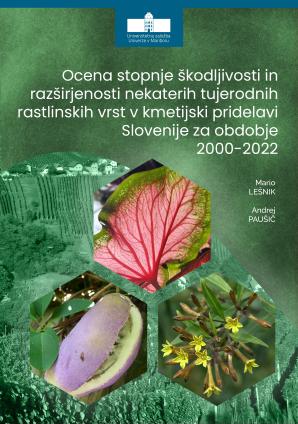Ocena stopnje škodljivosti in razširjenosti nekaterih tujerodnih rastlinskih vrst v kmetijski pridelavi Slovenije za obdobje 2000-2022
Keywords:
alochtonous species, harmfulness, agriculture, Slovenia, invasive plant speciesSynopsis
Assessment of the Degree of Harmfulness and Prevalence of Some Non-native Plant Species in Agricultural Production in Slovenia for the Period 2000-2022. In the period 2000-2022, an inventory of agricultural areas and some semi-natural border agricultural habitats throughout the territory of Slovenia was carried out, regarding the occurrence of non-native invasive plant taxa. Non-native plants were recorded, their population size was estimated and their harmfulness for agricultural production in Slovenia was assessed. Invasive plant species that are often mentioned in internationally recognized databases of invasive plants (e.g., DAISIE, CABI, EPPO, NOBANIS, ...) were considered in geographical areas that are comparable to ours in terms of climatic and pedological characteristics and in agricultural production system characteristics. In the introduction, the methodology for assessing the harmfulness of species is presented. We used 20 different criteria to assess the harmfulness. A third of the criteria is related to the plant species' morphological and ecological properties, a third to population spreading properties, and a third to data from the literature on the definition of harm to the environment, agricultural production, humans, and animals in published scientific studies. It was possible to give a different number of points for each criterion. All criteria were not completely equal in terms of possible awarded points. Based on the cumulative total of assigned points, the level of harmfulness of invasive species was divided into the following categories: I, I/II, II - designation for species/genera whose settlement on the territory of the Republic of Slovenia does not pose major risks for causing economic damage to agriculture, human and animal health and to natural habitats; II/III – species indicating that, according to some indicators from the risk analysis, they could have harmful effects, but there is currently insufficient information on their invasiveness available and on the degree of their adaptability to our climatic conditions; III - harmful species, where systematic control of occurrence is necessary for a definitive assessment of the level of harmfulness; III/IV - harmful species, where at least local action and administrative limitation actions against their spread are necessary; IV - species where general action and administrative limitation of dissemination is necessary; (*Z) - species with harmful effects on human and animal health; (U-NH*) – species with harmful effects on natural habitats. Data from 2000-2012 were compared, when analyzing 532 taxa, and 2012-2022 when the number of analyzed taxa of invasive plants increased to 704. In the period 2000-2012, the results of the analysis showed the following distribution of species harmfulness categories: I (8 species, 1.5%), I/II (98 species, 18.4%), II (233 species, 43.8%), II /III (122 species, 22.9%), III (50 species, 9.4%), III/IV (15 species, 2.8%), IV (6 species, 1.1%), *Z ( 37 species, 6.9%) and U-NH* (65 species, 12.2%). We estimated that economic or ecosystem damage will occur in 3.5 to 5.5% of the studied species. This means about 30 to 40 plant species would require immediate active administrative action. In the period 2012-2022, the results of the analysis showed the following distribution of species harmfulness categories: I (17 species, 2.4% of all), I/II (104 species, 14.8% of all), II (321 species, 45.6% of all ), II/III (166 species, 22.6% of the total), III (70 species, 9.9% of the total), III/IV (19 species, 2.7% of the total), IV (7 species, 1.1 % of total), *Z (100 species, 14.2% of total) and U-NH* (124 species, 17.5% of total). The results show that in the last period, not only the total number of inventoried invasive taxa increased, but also the percentage as well as the number of taxa of the categories *Z (100 species, 14.2% of all) and U-NH* (124 species, 17 .5% of all). A substantial proportion of the species discussed are plants introduced for cultivation as ornamental plants. For most species, it is possible to estimate the harmfulness quite realistically. A big unknown is the impact of climate change, especially minimum winter temperatures, which decide the long-term preservation of non-native perennial plants. Among them, many outgrow the natural vegetation. If they manage to survive the winter, they are dangerous invasives that can cause ecosystem damage. The availability of herbicides for invasive plants will also play an important role. If it decreases, some new species will gain in importance because we cannot effectively control them chemically. More and more species are ecologically problematic because they are intermediate hosts of new non-native pathogens and pests that threaten cultivated plants.
Downloads







